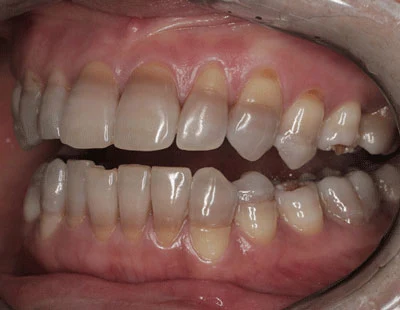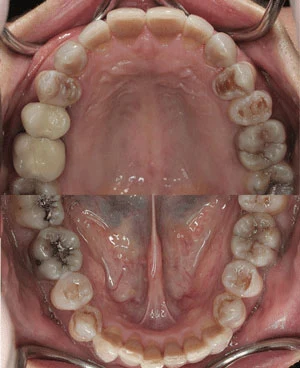Dental Hypoplasia Caused By Tetracycline

A hypoplasia is pathologically defined as a disruption during tooth development. A dental hypoplasia coincides with an insufficiency and/or irregular quantity of enamel and/or enamel. Tetracycline may cause dental hypoplasia when taken during pregnancy or by an infant or young child during tooth development. Therefore, if still the medication of choice in certain countries, it should not be administered during pregnancy or by children ages 8 and under.
Find a great smile makeover for another patient who has severe tetracycline stains.
Other conditions, such as Vitamin D deficiency during tooth development and calcification may also result in enamel and dentin hypoplasia. Vitamin D deficiency, caused by the lack of sun exposure in moderation, is still considered pandemic.
However, the most common form of dental hypoplasia that is encountered in Dr. Rabanus' cosmetic dental office in San Francisco is tetracycline-induced dental hypoplasia.

The coronal portion of the tooth consists of enamel, dentine and the pulp. Any change to these structures is likely to cause an alteration in the aesthetic appearance of the tooth associated to its light transmitting and reflecting properties. The appearance of tooth color depends on the quality of the reflected light, besides the quantity and quality of the incident light.
Intrinsic discoloration follows a change of the structural composition or thickness of the dental hard tissue. A variety of metabolic diseases and systemic factors affect the developing dentition and cause discolouration as a consequence. Some of the most common forms of intrinsic discoloration are
- Alkaptonuria
- Aging
- Congenital erythropoietic porphyria
- Congenital hyperbilirubinaemia
- Amelogenesis imperfecta
- Dentinogenesis imperfecta
- Tetracycline staining
- Fluorosis
- Enamel hypoplasia
Extrinsic discolouration is initiated at the outside of the tooth. It may be caused by metallic or non-metallic agents.
References:
Kashyap AS, Sharma HS. Discolouration of permanent teeth and enamel hypoplasia due to tetracycline. Postgraduate Medicine J. 1999; 75(890): 772.
Sánchez AR, et e;. Tetracycline and other tetracycline-derivative staining of the teeth and oral cavity. Int J Dermatol. 2004 Oct; 43(10): 709-15. Review.
Tredwin CJ, et al. Drug-induced disorders of teeth. J Dental Res. 2005 Jul; 84(7): 596-602. Review.
Thomas MS, et al. Medication-related tooth discoloration: a review. Dent Update. 2014 Jun; 41(5): 440-2, 445-7. Review.


